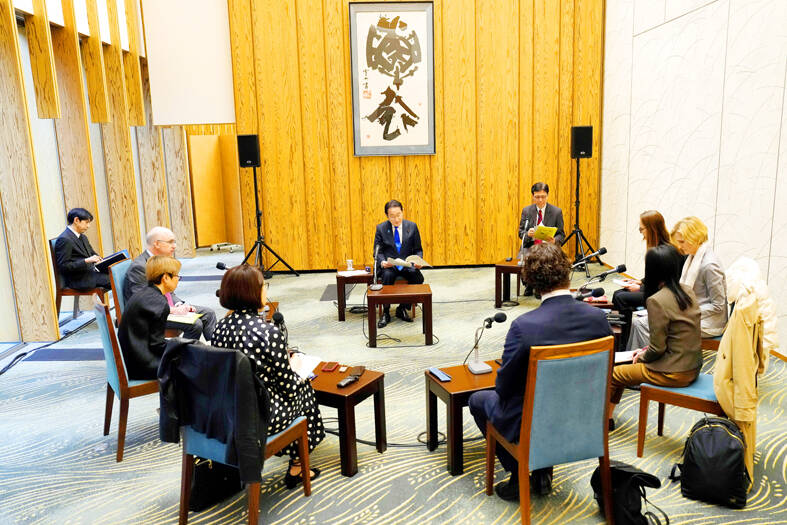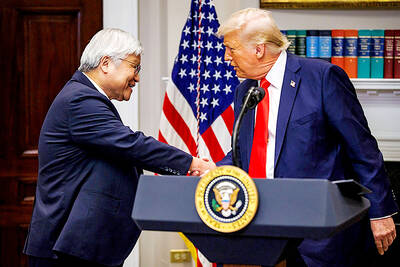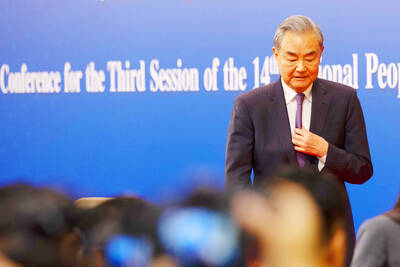Japanese Prime Minister Fumio Kishida yesterday said he would seek to build a multilayered defense network with other countries while bolstering military cooperation with the US as he seeks to strengthen Japan’s deterrence in a challenging security environment.
Speaking to a group of reporters at his official residence, Kishida also reiterated his commitment to achieving a lasting peace in Ukraine.
The comments come ahead of his trip to Washington for a summit with US President Joe Biden and a three-way leaders’ meeting with Philippine President Ferdinand Marcos Jr.

Photo: AP
“Pushing ahead on cooperation with like-minded countries on security, including defense equipment and technology, will lead to the establishment of a multilayered network, and by expanding that we can improve deterrence,” he said.
The prime minister is set to meet Biden one-on-one on Wednesday next week before the two hold the first-ever three-way summit with the Philippine leader.
Kishida and Marcos have each enhanced their bilateral military cooperation with their mutual ally as they confront separate territorial disputes with China, while Japan has transferred equipment such as radar units to the Philippines.
The three are to agree on joint naval patrols in the South China Sea later this year, Politico reported last month, a move that could provoke a strong reaction from China. They are also set to reach agreements on economic security issues like supply chains for nickel, the Nikkei Shimbun reported this week.
The US is seeking to develop a lattice-like structure whereby its allies cooperate among themselves as well as with Washington to counter China’s growing might. The trilateral summit with the Philippines follows on from a similar unprecedented meeting involving Japan and South Korea last year.
Kishida said he would seek to strengthen partnerships with Australia and the UK, but said nothing was decided on cooperation with the AUKUS group, of which both nations are members.
In related news, South Korea is in talks with China and Japan to host a three-way summit next month, Japanese and South Korean media reported, restoring a process that has been on hold since 2019 due to the COVID-19 pandemic and political tensions.
South Korea, which would likely host the long-delayed event, is looking to hold the summit late next month, the Chosun Ilbo newspaper reported yesterday, citing a government source it did not name.
Kyodo News of Japan reported earlier the meeting could be held next month and discussions are set to touch on economic cooperation and regional issues — citing diplomatic sources it did not name.
The office of South Korean President Yoon Suk-yeol reiterated that it has been in discussions for the three-way summit when asked about the reports and the Ministry of Foreign Affairs in Seoul said it would release a date for the event when one has been set.
South Korea has been pressing for months to resume the summit and foreign ministers from the three agreed in November to push for a meeting. However, momentum has slowed since then.
Japan’s top government spokesman, Yoshimasa Hayashi, told reporters yesterday that Tokyo would work with China and South Korea for a summit.

CRITICAL MOVE: TSMC’s plan to invest another US$100 billion in US chipmaking would boost Taiwan’s competitive edge in the global market, the premier said The government would ensure that the most advanced chipmaking technology stays in Taiwan while assisting Taiwan Semiconductor Manufacturing Co (TSMC, 台積電) in investing overseas, the Presidential Office said yesterday. The statement follows a joint announcement by the world’s largest contract chipmaker and US President Donald Trump on Monday that TSMC would invest an additional US$100 billion over the next four years to expand its semiconductor manufacturing operations in the US, which would include construction of three new chip fabrication plants, two advanced packaging facilities, and a research and development center. The government knew about the deal in advance and would assist, Presidential

‘DANGEROUS GAME’: Legislative Yuan budget cuts have already become a point of discussion for Democrats and Republicans in Washington, Elbridge Colby said Taiwan’s fall to China “would be a disaster for American interests” and Taipei must raise defense spending to deter Beijing, US President Donald Trump’s pick to lead Pentagon policy, Elbridge Colby, said on Tuesday during his US Senate confirmation hearing. The nominee for US undersecretary of defense for policy told the Armed Services Committee that Washington needs to motivate Taiwan to avoid a conflict with China and that he is “profoundly disturbed” about its perceived reluctance to raise defense spending closer to 10 percent of GDP. Colby, a China hawk who also served in the Pentagon in Trump’s first team,

SEPARATE: The MAC rebutted Beijing’s claim that Taiwan is China’s province, asserting that UN Resolution 2758 neither mentions Taiwan nor grants the PRC authority over it The “status quo” of democratic Taiwan and autocratic China not belonging to each other has long been recognized by the international community, the Mainland Affairs Council (MAC) said yesterday in its rebuttal of Beijing’s claim that Taiwan can only be represented in the UN as “Taiwan, Province of China.” Chinese Minister of Foreign Affairs Wang Yi (王毅) yesterday at a news conference of the third session at the 14th National People’s Congress said that Taiwan can only be referred to as “Taiwan, Province of China” at the UN. Taiwan is an inseparable part of Chinese territory, which is not only history but

INVESTMENT WATCH: The US activity would not affect the firm’s investment in Taiwan, where 11 production lines would likely be completed this year, C.C. Wei said Investments by Taiwan Semiconductor Manufacturing Co (TSMC, 台積電) in the US should not be a cause for concern, but rather seen as the moment that the company and Taiwan stepped into the global spotlight, President William Lai (賴清德) told a news conference at the Presidential Office in Taipei yesterday alongside TSMC chairman and chief executive officer C.C. Wei (魏哲家). Wei and US President Donald Trump in Washington on Monday announced plans to invest US$100 billion in the US to build three advanced foundries, two packaging plants, and a research and development center, after Trump threatened to slap tariffs on chips made